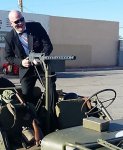acenipplelicker
Banned
:angels:
Twenty Interesting Facts About...Rosie the Riveter - Photo 2:2 cents:
Meredith chose to dress as “Rosie the Riveter” for our church’s Wednesday evening “Blast from the Past” theme. It was so much fun pulling together all the different pieces of her outfit. At the same time, in our search to see what the industrial women workers actually wore, the two of us turned up more information about this cultural icon than we previously knew from our studies.
Our attempt to make Meredith up as “Rosie the Riveter” was just another example of how learning walks hand in hand with daily life. I daresay what she learned while pulling together her own Rosie persona will stick in her brain much longer than anything she skimmed over in a textbook.
Here are 20 interesting things you may, or may not know, about “Rosie the Riveter.”
1. “Rosie the Riveter” wasn’t just one woman; she was much bigger than that, actually. Rosie was an iconic image representing the war time work and sacrifice of millions of women.
2. In fact, from 1940-1945, the female workforce increased in percentage from 27% to 37% as six million women answered the call to replace men in the workplace. Half of these women took on the tough jobs available in the defense industries.
3. In 1943, the U.S. aircraft industry employed more than 310,000 women, making up 65% of the industry’s total workforce (only 1% of women worked in this industry in the pre-war years).
4. Written by Redd Evans and John Jacob Loeb, the popular song, “Rosie the Riveter” was released in early 1943 and made famous by swing bandleader, James Kern “Kay” Kyser.
5. Some of the lyrics to the song describe Rosie as putting other girls to shame because “All day long whether rain or shine, she’s part of the assembly line. She’s making history working for victory” so that her Marine boyfriend, Charlie, fighting overseas can someday come home and marry her.
Rosie the Riveter - "We Can Do It" Poster:tinhat:
6. In 1942, the year before the Rosie song was released, the Westinghouse Company’s War Production Coordinating Committee commissioned J. Howard Miller to create a series of promotional posters for the war effort. The now famous, “We Can Do It!” poster proved to be the prototype for future “Rosie’s.”
7. Norman Rockwell was sure to have heard the “Rosie the Riveter” song when he painted his depiction of the female riveter for the cover of the May 29, 1943 Memorial Day issue of The Saturday Evening Post. Posed like the prophet Isaiah in Michelangelo’s famous fresco on the Sistine Chapel Ceiling, Rosie eats a sandwich while resting her foot on a copy of Hitler’s “Mein Kampf.” Her riveting gun and lunchbox sits on her lap.
Rosie the Riveter - Normal Rockwell
8. Rockwell’s model was not actually a female riveter at all, but a petite, 110-pound, 19-year-old phone operator in Arlington, Vermont named Mary Doyle Keefe. “He called me and apologized for making me so large.” explained Mary.
9. Though Rockwell’s image was the first depiction of “Rosie”, she is more widely recognized by J. Howard Miller’s image.
10. Due to copyright restrictions. on Rockwell’s poster, Miller’s “We Can Do It!” poster was picked up by the feminist movement of the 1980s as a modern symbol of female empowerment. It is now the image most commonly associated with Rosie.
Twenty Interesting Facts About...Rosie the Riveter - Photo 3
11. Although frequently associated with the contemporary women’s movement, Rosie the Riveter was never intended to promote change or enhance women’s standing in society or the workplace, but instead to represent the temporarily displaced homemaker whose sole purpose was to support the war effort by filling the industrial labor shortage due to the draft or enlistment.
12. Interestingly enough, though women who entered the workforce during World War II were crucial to the war effort, their pay lagged behind at about 50 percent of their male counterparts’ wages.
13. The press picked-up many “Rosie’s”, most of whom were named Rose, and varied in class, ethnicity, geography and background.
14. “The daughter of Italian immigrants, Rose Bonavita worked as a riveter at the General Motors Eastern Aircraft Division in North Tarrytown, NY. Together with her partner, Jennie Florio, she set a production record by drilling nine hundred holes and driving thirty-three hundred rivets in the tail end of a Grumman TBF Avenger torpedo bomber during one six-hour overnight shift in June 1943.”
Twenty Interesting Facts About...Rosie the Riveter - Photo 2:2 cents:
Meredith chose to dress as “Rosie the Riveter” for our church’s Wednesday evening “Blast from the Past” theme. It was so much fun pulling together all the different pieces of her outfit. At the same time, in our search to see what the industrial women workers actually wore, the two of us turned up more information about this cultural icon than we previously knew from our studies.
Our attempt to make Meredith up as “Rosie the Riveter” was just another example of how learning walks hand in hand with daily life. I daresay what she learned while pulling together her own Rosie persona will stick in her brain much longer than anything she skimmed over in a textbook.
Here are 20 interesting things you may, or may not know, about “Rosie the Riveter.”
1. “Rosie the Riveter” wasn’t just one woman; she was much bigger than that, actually. Rosie was an iconic image representing the war time work and sacrifice of millions of women.
2. In fact, from 1940-1945, the female workforce increased in percentage from 27% to 37% as six million women answered the call to replace men in the workplace. Half of these women took on the tough jobs available in the defense industries.
3. In 1943, the U.S. aircraft industry employed more than 310,000 women, making up 65% of the industry’s total workforce (only 1% of women worked in this industry in the pre-war years).
4. Written by Redd Evans and John Jacob Loeb, the popular song, “Rosie the Riveter” was released in early 1943 and made famous by swing bandleader, James Kern “Kay” Kyser.
5. Some of the lyrics to the song describe Rosie as putting other girls to shame because “All day long whether rain or shine, she’s part of the assembly line. She’s making history working for victory” so that her Marine boyfriend, Charlie, fighting overseas can someday come home and marry her.
Rosie the Riveter - "We Can Do It" Poster:tinhat:
6. In 1942, the year before the Rosie song was released, the Westinghouse Company’s War Production Coordinating Committee commissioned J. Howard Miller to create a series of promotional posters for the war effort. The now famous, “We Can Do It!” poster proved to be the prototype for future “Rosie’s.”
7. Norman Rockwell was sure to have heard the “Rosie the Riveter” song when he painted his depiction of the female riveter for the cover of the May 29, 1943 Memorial Day issue of The Saturday Evening Post. Posed like the prophet Isaiah in Michelangelo’s famous fresco on the Sistine Chapel Ceiling, Rosie eats a sandwich while resting her foot on a copy of Hitler’s “Mein Kampf.” Her riveting gun and lunchbox sits on her lap.
Rosie the Riveter - Normal Rockwell
8. Rockwell’s model was not actually a female riveter at all, but a petite, 110-pound, 19-year-old phone operator in Arlington, Vermont named Mary Doyle Keefe. “He called me and apologized for making me so large.” explained Mary.
9. Though Rockwell’s image was the first depiction of “Rosie”, she is more widely recognized by J. Howard Miller’s image.
10. Due to copyright restrictions. on Rockwell’s poster, Miller’s “We Can Do It!” poster was picked up by the feminist movement of the 1980s as a modern symbol of female empowerment. It is now the image most commonly associated with Rosie.
Twenty Interesting Facts About...Rosie the Riveter - Photo 3
11. Although frequently associated with the contemporary women’s movement, Rosie the Riveter was never intended to promote change or enhance women’s standing in society or the workplace, but instead to represent the temporarily displaced homemaker whose sole purpose was to support the war effort by filling the industrial labor shortage due to the draft or enlistment.
12. Interestingly enough, though women who entered the workforce during World War II were crucial to the war effort, their pay lagged behind at about 50 percent of their male counterparts’ wages.
13. The press picked-up many “Rosie’s”, most of whom were named Rose, and varied in class, ethnicity, geography and background.
14. “The daughter of Italian immigrants, Rose Bonavita worked as a riveter at the General Motors Eastern Aircraft Division in North Tarrytown, NY. Together with her partner, Jennie Florio, she set a production record by drilling nine hundred holes and driving thirty-three hundred rivets in the tail end of a Grumman TBF Avenger torpedo bomber during one six-hour overnight shift in June 1943.”


